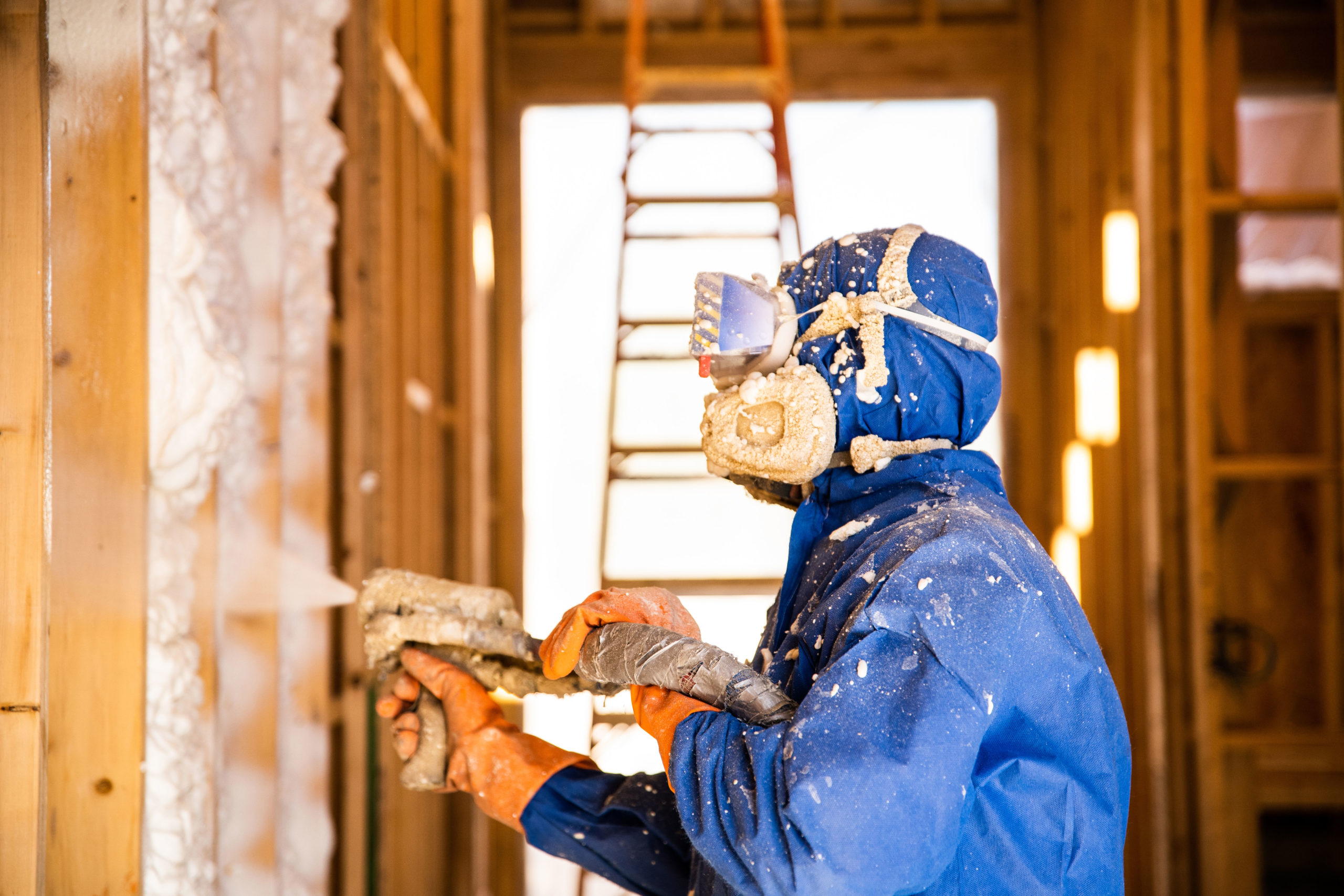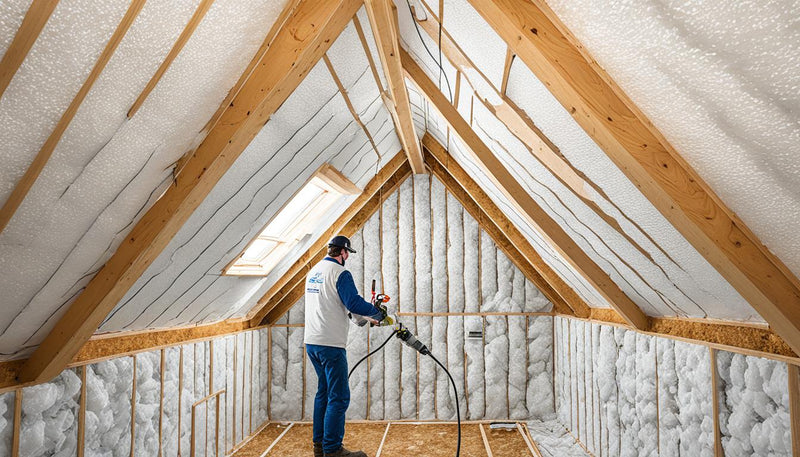Understanding the Benefits of Using Spray Foam for Insulation Projects
Understanding the Benefits of Using Spray Foam for Insulation Projects
Blog Article
Spray Foam: The Ultimate Remedy for Air Sealing and Insulation
Spray foam insulation has actually emerged as a leading option for efficient air sealing and thermal insulation, supplying an one-of-a-kind combination of buildings that set it apart from standard techniques. Its capacity to increase and load voids makes it especially effective in preventing air leakage, which can dramatically influence power effectiveness. Understanding the full range of its benefits, installation processes, and contrasts with other insulation kinds is vital for making notified decisions. As we check out these aspects, the effects for both new buildings and retrofits become significantly considerable. What factors should affect your selection?
What Is Spray Foam?
Spray foam is a flexible insulation material that incorporates the concepts of air sealing and thermal resistance to improve power efficiency in buildings. Composed mostly of polyurethane or other comparable substances, spray foam is used as a liquid that broadens upon call with surfaces, creating a solid, continuous layer of insulation. This one-of-a-kind building enables it to fill spaces, fractures, and voids that traditional insulation products might ignore, offering a remarkable air seal.
There are two main sorts of spray foam: open-cell and closed-cell. Open-cell spray foam is lighter and more adaptable, using excellent sound absorption and a reduced R-value per inch - Spray Foam. On the other hand, closed-cell spray foam is denser, offering a greater R-value, dampness resistance, and included structural stability to developing elements
The application procedure usually involves specific equipment, ensuring a seamless application that complies with different substrates, including steel, concrete, and wood. This versatility makes spray foam ideal for both new building and constructions and retrofitting existing frameworks. Its ability to produce a closed barrier significantly contributes to reducing power intake and improving indoor air top quality, thereby making it a favored choice among house owners and contractors alike.
Advantages of Spray Foam Insulation
Among the most substantial benefits of spray foam insulation is its extraordinary capability to develop a continual air obstacle, which properly decreases energy loss. Unlike conventional insulation materials, spray foam expands to load fractures and spaces, ensuring that air leakage is drastically reduced. This characteristic not just improves energy efficiency however also leads to reduce energy bills with time.
In addition, spray foam insulation gives premium thermal resistance, adding to a much more steady interior atmosphere. Its high R-value per inch enables effective insulation in confined areas, making it optimal for attics, wall surfaces, and crawl areas. Furthermore, the moisture-resistant residential or commercial properties of spray foam aid prevent mold and mold development, promoting much healthier living problems.
An additional vital benefit of spray foam insulation is its sound-dampening qualities (Spray Foam). It efficiently decreases noise transmission between spaces, producing a quieter and much more comfortable home environment. The longevity of spray foam additionally stands out, as it does not droop or clear up with time, maintaining its performance throughout its life expectancy
Just How Spray Foam Works
Comprehending how spray foam insulation functions is vital for appreciating its efficiency in air sealing and thermal resistance. Spray foam insulation includes 2 key components: isocyanate and polyol material. When these parts are mixed, they undertake a chemical response that causes the product to expand swiftly, creating a thick foam that fills up cavities, gaps, and splits.
As the foam expands, it complies with surfaces, developing an airtight seal that substantially reduces air seepage. This characteristic makes spray foam insulation highly efficient at avoiding drafts and dampness infiltration, which can bring about power loss and damage gradually. Additionally, the closed-cell variant of spray foam uses exceptional thermal resistance due to its inflexible structure, effectively reducing warm transfer.
The distinct residential properties of spray foam allow it to satisfy uneven surfaces, making sure comprehensive insurance coverage and a smooth obstacle. Consequently, spray foam insulation not just boosts energy efficiency however likewise adds to boosted indoor air top quality by minimizing the build-up of allergens and contaminants. Inevitably, comprehending the mechanics behind spray foam underscores its role as a superior option for insulation and air sealing in both property and industrial applications.
Installation Process Review

Prior to installation, the area needs to be effectively cleansed and prepped, making visit their website certain that surfaces are without particles, dirt, and dampness. This action is vital due to the fact that contaminants can jeopardize bond and general performance. Once the area is prepared, the application involves mixing both elements of the spray foam, which increases upon get in touch with and fills spaces effectively.
Trained experts must carry out the installment, making use of customized devices to make sure consistent protection and optimum density. Safety preventative measures, consisting of putting on protective equipment and making certain appropriate ventilation, are necessary during this process. After application, the foam typically treatments rapidly, developing a strong obstacle that enhances energy efficiency.
Comparing Spray Foam to Traditional Insulation
When examining insulation choices, spray foam insulation stands out in contrast to typical materials such as fiberglass and cellulose. Unlike fiberglass and cellulose, which can allow air infiltration, spray foam expands upon application, filling up gaps and voids to create a closed seal.
Additionally, spray foam offers a greater R-value per inch than conventional insulation types, providing even more effective thermal resistance in a thinner profile. This characteristic is particularly helpful precede with restricted cavity deepness. Spray foam is immune to wetness and mold growth, which can be a considerable problem with cellulose and fiberglass, specifically in damp atmospheres.
However, spray foam insulation usually lugs a higher in advance expense than its traditional counterparts. Property owners need to evaluate this preliminary investment versus long-term energy savings and performance advantages. Ultimately, while both insulation kinds here are the findings serve their purpose, spray foam arises as a more sophisticated remedy for modern-day insulation requirements, particularly in regards to air securing and thermal effectiveness.

Conclusion
In recap, spray foam insulation represents an extremely reliable option for accomplishing optimum air securing and thermal resistance. Its one-of-a-kind homes, including dampness resistance and noise dampening, make it ideal for various applications in both brand-new building and constructions and retrofitting jobs (Spray Foam). Although the initial prices might be higher compared to standard insulation materials, the lasting benefits, such as considerable power cost savings and improved interior air high quality, justify the financial investment and highlight its value in modern-day building techniques.
Spray foam insulation has arised as a leading read this option for efficient air securing and thermal insulation, offering an one-of-a-kind combination of residential properties that set it apart from typical approaches.Spray foam is a functional insulation material that integrates the principles of air sealing and thermal resistance to boost energy efficiency in structures.When evaluating insulation alternatives, spray foam insulation stands out in comparison to traditional products such as fiberglass and cellulose. Eventually, while both insulation kinds serve their objective, spray foam arises as an extra sophisticated solution for modern insulation demands, particularly in terms of air securing and thermal effectiveness.
In summary, spray foam insulation represents a very efficient service for attaining ideal air sealing and thermal resistance.
Report this page